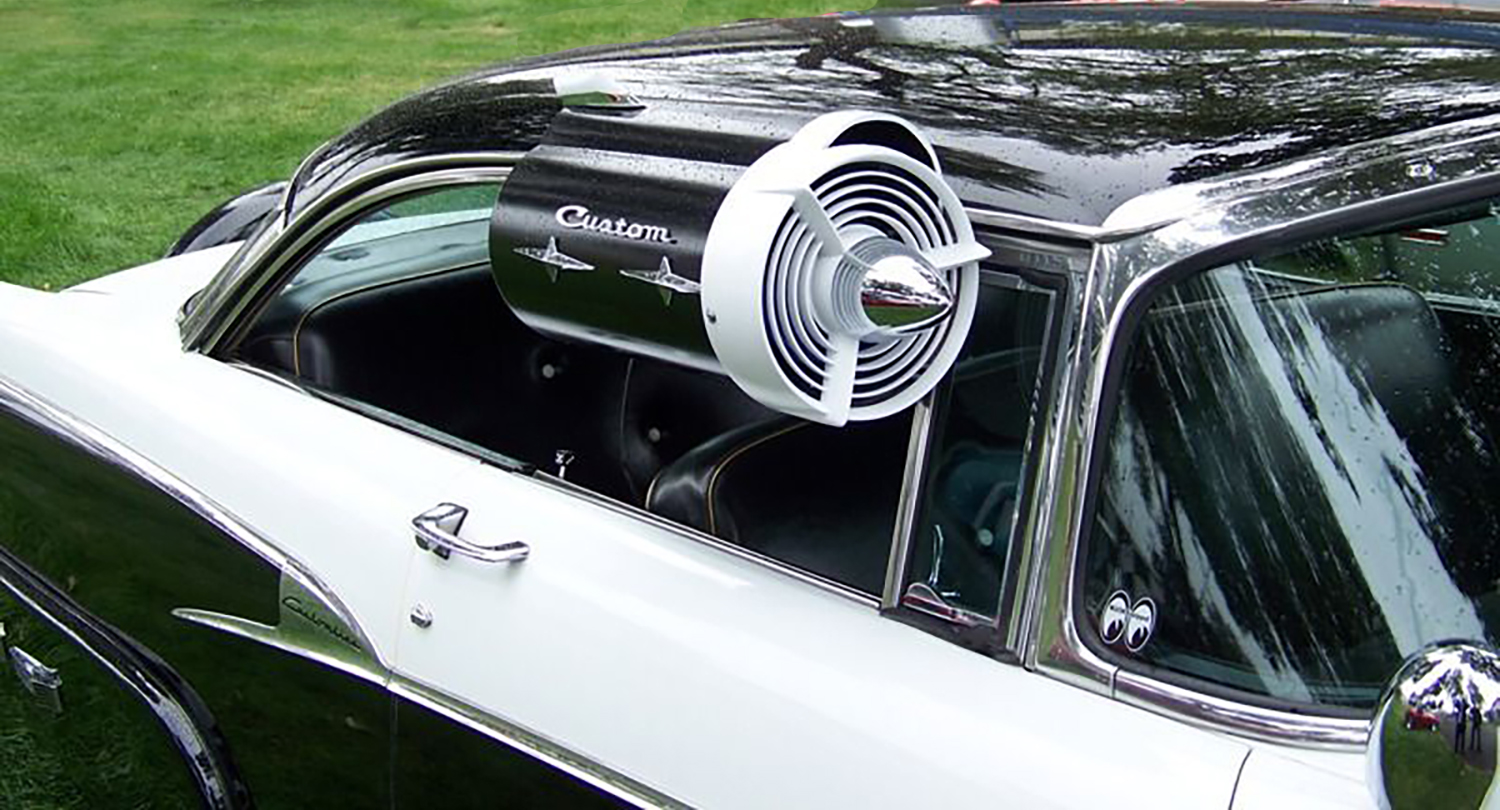When you are next driving along enjoying your car’s air con, maybe think about Queen Elizabeth II. She was, after all, the one who inadvertently kick-started the mobile air-conditioning industry in Australia. No, really. How so?
Gold Coast businessmen and authors Mark Mitchell and Ken Newton tell us how in their massive, door-stopper of a book (it’s 683 pages) Cool Mavericks, the surprisingly interesting history of an industry that has never been more relevant than it is today.
Our troops in Afghanistan were certainly grateful for air-conditioned Bushmasters. The Bushmaster Protected Mobility Vehicle or Infantry Mobility Vehicle is an Australian-built four-wheel drive armoured vehicle which we have also gifted to Ukraine. The many and varied uses of mobile air conditioning, including in our mining industry, are outlined in the book.
Mitchell was founding president of VASA, the first advocacy organisation in Australia for the mobile air-conditioning industry. Newton was VASA’s first CEO and publicist. He’s also a bit of a legend in Gold Coast and Queensland media circles.
Mitchell’s previous books include The Sultan of Slide – a privateer’s story, which celebrates the life of his father, Bob Mitchell, an internationally renowned sidecar racer on the Grand Prix circuits of Europe in the 1950s.
His second book was Unicla and the Midnight Technician, the story of Unicla, a company that designs and manufactures heavy-duty air-conditioning compressors. Unicla is the only independent automotive compressor manufacturer in the world and Unicla International is celebrating its 60th anniversary in October. It recently won best product in an engineering class at the Australian Good Design Awards. (Mitchell received the coveted award at a ceremony at Sydney’s International Convention Centre this month.)
Unicla International is owned by Mitchell and his Hong Kong-based partner Peter Yee. With a head office in Hong Kong, a manufacturing plant in China and manufacturing, design and testing at a research and development centre in Australia, Unicla now has a global reach and an impressive following of high-profile customers.
Unicla compressors can be found on truck and vehicle chassis built by Daimler of Germany; on vehicles manufactured by Thales, the global defence industry specialist; and on railway locomotives, earthmoving machines, mining equipment and refrigerated trailers around the world.
Mitchell is also chairman of the Queensland-based Supercool group of companies. But back to the Queen. At the launch of Cool Mavericks recently at The Westin Brisbane, Mitchell pointed out that there are many fascinating stories in the development of the industry and one involves the late monarch.
“There is the story of the larrikin Melbourne taxi owner who started the industry here in Australia and air-conditioned Queen Elizabeth’s car so she could stand the heat during her first visit to Australia,” Mitchell told the assembled throng.
The Queen’s tour of Australia during the summer months between 1953 and 1954 covered all states and territories barring the Northern Territory. How to keep her cool in her flash Daimlers? (Four were used during the visit.)
As the authors report: “Adelaide’s The Advertiser, in a November 1953 snippet, said the cars would be fitted with special equipment capable of lowering the inside temperature of the car by 13 degrees. The equipment was designed and built in Australia, but no names were mentioned. However, the Kalgoorlie Miner in September the same year revealed that a Melbourne firm had produced a refrigeration system which would keep the Queen’s car cool under the hottest sun.”
According to the authors, who did quite a lot of digging, the company Marlandaire is thought to have been the installer of the air-conditioning system in the Queen’s Daimlers. The technology had been imported from America in the 1950s but, as a historical watershed in Australia, the Queen’s visit serves pretty well.
Car air conditioning is something we now take for granted. We shouldn’t because it has been a long and sometimes tortuous route to get us where we are today, blithely expecting every car to be fully air-conditioned.
Cool Mavericks traces the beginnings of the mobile air-conditioning era in Australia and the emergence of what became a temporary, but highly lucrative and frantically busy industry. The book documents the colourful characters who leapt into the unknown and made air conditioning everything on wheels a highly successful and quite accidental industry. It uncovers the vital discoveries that had to be made before it was possible to air condition anything that moved.
Refrigeration in all its forms had to be invented and a refrigerant found that could be used safely in a vehicle. Flexible hoses had to be created – rigid fluid lines wouldn’t last five minutes in a 1940s car. The physical componentry of air conditioning had to be thought out and patented.
Finally, somebody had to figure out how to stuff all this gear into a machine that was never designed to be mechanically air conditioned in the first place. It wasn’t until the 1940s in the US that a cooling system based on refrigeration that would work in a moving vehicle was developed. In Texas some maverick mechanics and businessmen pinched the only ideas that were available from Detroit car making engineers and inventors.
Others jumped on the bandwagon and these independent after-market players in the US, Australia and Japan were inventing, experimenting and designing air-conditioning systems that could be fitted into almost every vehicle on the road. The car makers had missed their opportunity and would not get it back until the 1990s.
Air conditioning of vehicles of all kinds was an unplanned industry that hit Australian shores in the 1950s and remained unruly for much of its life. What made it so was its cast of colourful characters in the US and Australia who beavered away in their often grease-encrusted garages and backyard sheds and managed to devise an air-conditioning system that became the blueprint for all future mobile air conditioning.
You will meet these characters in the book, which features a lively narrative as well as technical details that may be over our heads. Mitchell himself is a pioneer of the industry. His SuperCool Car Air Conditioning retail business at Southport on the Gold Coast was Australia’s first purpose-built vehicle air-conditioning workshop with automated refrigerant recovery technology.
While launching Cool Mavericks in Brisbane, Mitchell gave a number of examples (including the Queen’s visit) of seminal events in the history of mobile air conditioning: “There is also the story of a young man who was so hell bent on solving leaking pipes on oil rigs and aircraft bombers that he ended up inventing the modern car air-conditioning hose,” Mitchell said. “This was the hose technology that propelled the Apollo missions into space.”
A modern-day example of the continuing development is, as Mitchell pointed out at the launch, the original Tesla Model S electric vehicle.
“Elon Musk gets all the attention and accolades for it and, of course, it is warranted,” Mitchell said. “But Elon knows, and so does anyone intimate with the technology within this vehicle, that without the innovation and genius of a Cool Maverick – one Vince Johnston – the Model S wouldn’t be going anywhere. Vince invented and patented a water glycol circuit that switches twin and triple heat exchangers from parallel to series flow to maximise heating and cooling of the vehicle battery. It’s one of the secrets inside a Tesla.

Get InReview in your inbox – free each Saturday. Local arts and culture – covered.
Thanks for signing up to the InReview newsletter.
“But guess what? Vince is a modest man and not much has ever been said about him, until now. And that is the significant point of this book. Most of our Cool Mavericks in this book have never received any recognition for their achievements. Until now.” (Johnston has read the book and appreciates his mention.)
It’s fascinating stuff that will help you channel your inner nerd and readers will enjoy the retro design aspects inherent in the book, including some of the advertising over the years. Cool it! With Holden Air promises one such ad. Love it.
Cool Mavericks by Mark Mitchell and Ken Newton. For Australian orders, the book price is $132 plus $30 postage – anywhere in Australia.
Support local arts journalism
Your support will help us continue the important work of InReview in publishing free professional journalism that celebrates, interrogates and amplifies arts and culture in South Australia.
Donate Here




